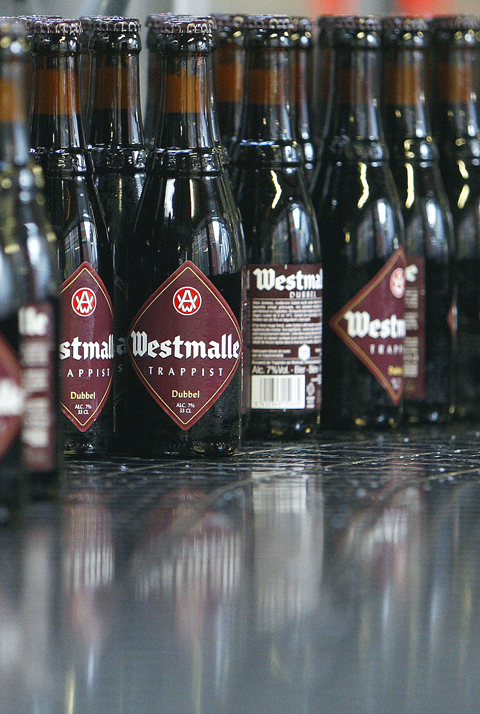A gold standard for beer connoisseurs, the Trappist ale in Westmalle Abbey streams through state-of-the-art equipment with not a monk in sight.
It’s thoroughly in accord with strict criteria — that brewing be carried out within the walls of a Trappist abbey and controlled by monks — but shows the changes wrought on the potent ales by modern life and aging monastic populations.
“The requirements are a lot greater these days,” said Westmalle director Philippe Van Assche as he stood beside a 10 million euro (US$15 million) bottling plant. “You need a lab, there are health standards to meet, bottling too — so a certain size is required.”

PHOTO: REUTERS WARNING: EXCESSIVE CONSUMPTION OF ALCOHOL CAN DAM
Achel, Chimay, Orval, Rochefort, Westmalle and Westvleteren from Belgium and La Trappe from the Netherlands are the world’s only Trappist brews.
They are distinct in Belgium from Abbey beers, which are commercially produced with links to a monastery or just given monastic branding. Anheuser-Busch InBev’s Leffe, for example, is named after a real abbey, but brewed in a 6 million hectoliter capacity plant.
“Trappist beers are the ultimate appellation controlee in the beer world,” said Tim Webb, author of Good Beer Guide Belgium. “Trappist breweries wish to be great quality, although there are some great Abbey beers around.”
But the average age of monks in their late 60s or 70s in some abbeys begs questions about the future.
Some communities could disappear, acknowledges the abbot of Koningshoeven Abbey in the Netherlands, where monks still prepare gift packages of its La Trappe beer.
“Keeping the brewery going then would not be part of our philosophy,” said Brother Bernardus. “The brewery is there to serve the community, not the other way round.”
For now, business is rosy, resisting a global trend of declining volumes and a recessionary shift to cheaper brands. People with a penchant for Chimay or Westmalle are still prepared to pay for their luxury tipple.
Monks may no longer show up on the factory floor at Westmalle, but they ensure its marketing is earnest and have capped production at 12 million liters, making it the second largest Trappist brewer, after Chimay.
‘ORA ET LABORA’
“There’s more demand than we can supply. We’ve not seen any tail-off,” said Van Assche, adding that the monks on the brewery’s board had decided to limit volumes. “We’re here to serve the abbey and, according to the monks, we make enough.”
A manifestation of the injunction ora et labora (pray and work), Trappist beers have been brewed in abbeys for centuries.
SELF-SUPPORTING
The tenet that monasteries be self-supporting has also led Benedictines in southern Germany to brew the likes of Andechs, Ettal and Weltenburg.
Trappist beers have acquired a high profile, partly thanks to beer lovers on the Internet who like the fact most of the profit goes to charitable projects.
“There’s a lot of feel-good imagery, some of which is justified,” beer expert Webb said. “The profit is going to a charitable cause rather than an executive’s Mercedes.”
Success has come despite no advertising, sober marketing and business practices that may seem antiquated.
Westmalle gives no reduction for buying in bulk — the wholesale price is the same for 1 bottle or 1,000. A decade ago Belgian retailers protested by clearing Westmalle from their shelves, but later relented due to consumer demand.
Van Assche pulls from a cupboard samples of campaigns for commercial Abbey beers: a picture of women in monks’ habits and suggestive copy such as “the red-head with character,” pointing out this is the sort of thing the monks would never allow.
Many Trappist brewers go no further than providing beer mats and glasses and a cafe at their doorsteps.
“Some argue we are like cuckoos — we have no bars of our own, but we’re still present,” said Van Assche, referring to the birds’ habit of using the nests of others.
Chimay, the most internationally recognized Trappist beer, has pushed the hardest commercially, exporting around 45 percent of its 160,000 hectoliter output.
DELICATE BALANCE
“We do a little more than the other breweries. We have posters and road signs,” commercial director Philippe Henroz said. “The beer doesn’t sell by itself.”
Chimay’s larger scale is partly because the monks were keen to revive a local economy battered by World War II. Beer sales help to support 95 lay workers and abbeys abroad.
“I can imagine that there are people asking whether the commercial activities have become more important than the life of the abbey community. It’s a delicate balance,” said Francois de Harenne, director of the Orval brewery, with a purely lay staff since its foundation in 1931.
Westvleteren has gone to the opposite extreme, with a limited 4,500 hectoliters still brewed by monks. Its beer is only sold in crates to individuals at the gates on the understanding that they do not resell it commercially.
It has faced problems, such as in 2005 when demand exploded after an aficionados’ Web site declared one of its beers the best in the world. Even today, commercial operators flout its ban on reselling with some mark-ups as much as 10-fold.
RECRUITING
“There used to be huge traffic congestion on days of sale ... Now people must reserve in advance, so now it’s the telephone line that’s jammed,” said brewery chief Brother Joris.
Given that Trappist beer is a means to an end, few of the brewers seem agitated by the prospect of it dying out with aging monastic communities.
“We can hardly recruit with an advert in the newspaper,” said Brother Antoine, the former head of the Rochefort brewery.
Westvleteren’s Brother Joris said it was not a near-term issue: other abbeys might send their monks to help.
“We would also have to take into account the socio-economic significance,” he said, pointing out the risk of lay unemployment.
Koningshoeven’s Brother Bernardus said another possibility was for brewing to shift to reflect monk demographics. Religious vocations are on the rise in Africa and India.
“Maybe our brothers in Africa will start an African Trappist brewery,” he said. “That would be a fascinating future.”

AIR SUPPORT: The Ministry of National Defense thanked the US for the delivery, adding that it was an indicator of the White House’s commitment to the Taiwan Relations Act Deputy Minister of National Defense Po Horng-huei (柏鴻輝) and Representative to the US Alexander Yui on Friday attended a delivery ceremony for the first of Taiwan’s long-awaited 66 F-16C/D Block 70 jets at a Lockheed Martin Corp factory in Greenville, South Carolina. “We are so proud to be the global home of the F-16 and to support Taiwan’s air defense capabilities,” US Representative William Timmons wrote on X, alongside a photograph of Taiwanese and US officials at the event. The F-16C/D Block 70 jets Taiwan ordered have the same capabilities as aircraft that had been upgraded to F-16Vs. The batch of Lockheed Martin

GRIDLOCK: The National Fire Agency’s Special Search and Rescue team is on standby to travel to the countries to help out with the rescue effort A powerful earthquake rocked Myanmar and neighboring Thailand yesterday, killing at least three people in Bangkok and burying dozens when a high-rise building under construction collapsed. Footage shared on social media from Myanmar’s second-largest city showed widespread destruction, raising fears that many were trapped under the rubble or killed. The magnitude 7.7 earthquake, with an epicenter near Mandalay in Myanmar, struck at midday and was followed by a strong magnitude 6.4 aftershock. The extent of death, injury and destruction — especially in Myanmar, which is embroiled in a civil war and where information is tightly controlled at the best of times —

China's military today said it began joint army, navy and rocket force exercises around Taiwan to "serve as a stern warning and powerful deterrent against Taiwanese independence," calling President William Lai (賴清德) a "parasite." The exercises come after Lai called Beijing a "foreign hostile force" last month. More than 10 Chinese military ships approached close to Taiwan's 24 nautical mile (44.4km) contiguous zone this morning and Taiwan sent its own warships to respond, two senior Taiwanese officials said. Taiwan has not yet detected any live fire by the Chinese military so far, one of the officials said. The drills took place after US Secretary

THUGGISH BEHAVIOR: Encouraging people to report independence supporters is another intimidation tactic that threatens cross-strait peace, the state department said China setting up an online system for reporting “Taiwanese independence” advocates is an “irresponsible and reprehensible” act, a US government spokesperson said on Friday. “China’s call for private individuals to report on alleged ‘persecution or suppression’ by supposed ‘Taiwan independence henchmen and accomplices’ is irresponsible and reprehensible,” an unnamed US Department of State spokesperson told the Central News Agency in an e-mail. The move is part of Beijing’s “intimidation campaign” against Taiwan and its supporters, and is “threatening free speech around the world, destabilizing the Indo-Pacific region, and deliberately eroding the cross-strait status quo,” the spokesperson said. The Chinese Communist Party’s “threats